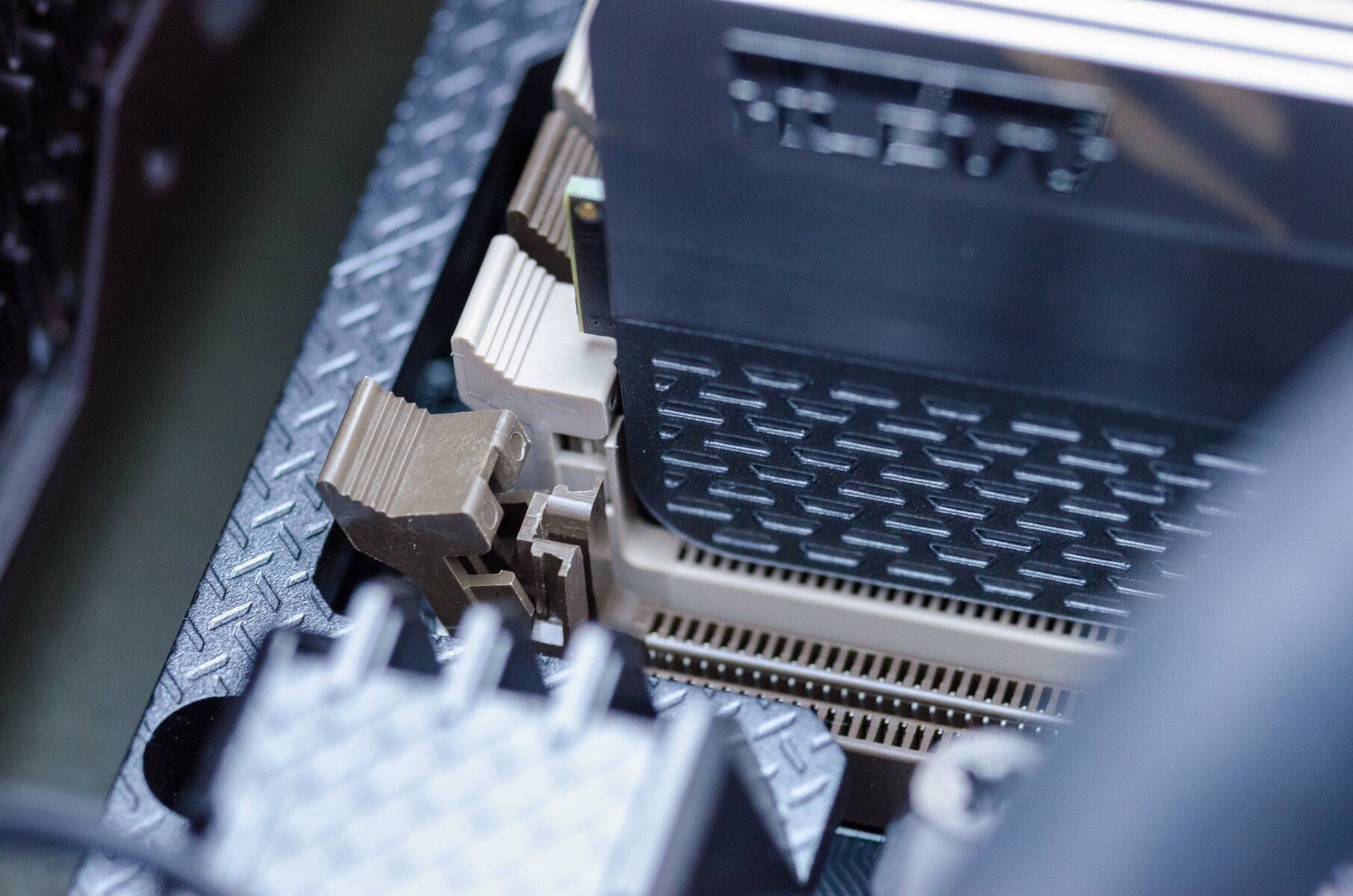Introduction
Welcome to the thrilling world of Phasmophobia, the popular multiplayer horror game that has taken the gaming community by storm. As you immerse yourself in the haunting atmosphere and spine-chilling encounters, you might ponder an important question: how much RAM do you need for Phasmophobia?
RAM, or Random Access Memory, plays a crucial role in gaming performance. It is responsible for temporarily storing the game files and data that your computer needs to run smoothly. The amount of RAM you have can significantly impact the game’s overall performance, including its loading times, frame rates, and responsiveness.
Before diving into the specific RAM requirements for Phasmophobia, let’s get a better understanding of the game itself. Phasmophobia is a cooperative horror game where you and your friends become paranormal investigators, exploring haunted locations to gather evidence of supernatural activity. With its intense atmosphere, realistic graphics, and sophisticated AI, Phasmophobia demands a capable computer system to fully enjoy its haunting experience.
Now that we know the importance of RAM in gaming, let’s explore the minimum and recommended requirements for Phasmophobia.
Understanding Phasmophobia
Phasmophobia is a unique multiplayer horror game developed by Kinetic Games. It puts players in the shoes of paranormal investigators, exploring haunted locations in search of evidence of supernatural activity. The game offers a thrilling and atmospheric experience, combining elements of exploration, puzzle-solving, and cooperative gameplay.
One of the standout features of Phasmophobia is its emphasis on realism. The game utilizes realistic graphics, ambient sounds, and intelligent AI to create an immersive and terrifying experience. From creaking doors to flickering lights, every detail is meticulously crafted to add to the tension and fear.
As a paranormal investigator, your primary goal is to identify the type of ghost haunting the location. This is achieved by gathering evidence through various means, such as using EMF readers, spirit boxes, and thermal cameras. Each ghost has unique characteristics and behavior patterns, which adds to the challenge and unpredictability of the gameplay.
Moreover, Phasmophobia is designed to be a cooperative experience. You can team up with up to three other players to investigate haunted locations together. Communication and teamwork are crucial as you work together to collect evidence, document supernatural occurrences, and try to survive the chilling encounters with the ghosts.
The game features a wide variety of haunted locations to explore, including houses, schools, asylums, and prisons. Each location has its own set of challenges and dangers, keeping players engaged and on their toes. With its dynamic gameplay and replayability, Phasmophobia offers a truly immersive horror experience that will keep you coming back for more.
Now that we have a better understanding of Phasmophobia, let’s delve into the role of RAM in enhancing your gaming experience.
The Role of RAM in Gaming
RAM, or Random Access Memory, is an essential component of any gaming setup. It plays a crucial role in the overall performance and smooth running of games, including Phasmophobia. RAM acts as a temporary storage space for the data that your computer needs to access quickly while gaming.
When you play Phasmophobia, your computer needs to load various game files, textures, and other data into memory. Having enough RAM ensures that these files can be quickly accessed, resulting in faster loading times and smoother gameplay. Without proper RAM resources, your computer may need to constantly retrieve data from slower storage devices, such as hard drives, which can lead to lag and performance issues.
In addition to loading times, RAM also impacts the game’s frame rates and responsiveness. When you encounter intense moments in Phasmophobia, such as ghost sightings or paranormal events, the game may require additional resources to render the graphics and generate real-time effects. Insufficient RAM can lead to lower frame rates, stuttering, and even freezing, hindering your immersion and enjoyment of the game.
Furthermore, RAM plays a role in multitasking during gaming sessions. Gaming often involves running multiple processes in the background, such as voice chat applications, streaming software, or web browsers. Having enough RAM allows your computer to handle these tasks simultaneously without impacting the game’s performance. This is particularly important for multiplayer games like Phasmophobia, where communication and coordination with teammates are vital.
Overall, RAM is a crucial component that significantly impacts the performance of Phasmophobia and other games. Having enough RAM ensures faster loading times, smoother gameplay, higher frame rates, and the ability to multitask seamlessly. As we explore the RAM requirements for Phasmophobia, we’ll discuss both the minimum and recommended specifications to ensure optimal gaming experience.
Minimum Requirements for Phasmophobia
To enjoy Phasmophobia and its haunting thrills, your computer needs to meet the minimum system requirements. While these specifications will allow you to run the game, keep in mind that they may result in lower graphics settings and potentially affect overall performance.
Here are the minimum requirements for Phasmophobia:
- Operating System: Windows 10 64-bit
- Processor: Intel Core i5-4590 / AMD FX 8350
- RAM: 8GB
- Graphics: NVIDIA GTX 970 / AMD Radeon R9 290
- DirectX: Version 11
- Storage: 15GB available space
- Sound Card: DirectX compatible
These specifications serve as a baseline for running Phasmophobia. While the game will be playable with these requirements, you may need to lower graphical settings to achieve smoother performance. The listed CPU and GPU provide the minimum processing power and graphical capabilities necessary to run the game, but may not deliver the optimal visual experience. As with any game, upgrading beyond the minimum requirements can greatly enhance your gaming experience.
Now that we’ve covered the minimum system requirements for Phasmophobia, let’s explore the recommended specifications for an optimal gaming experience.
Recommended Requirements for Phasmophobia
If you want to fully immerse yourself in the eerie world of Phasmophobia and experience the game with enhanced graphics and smooth performance, it’s recommended to meet or exceed the following system requirements:
- Operating System: Windows 10 64-bit
- Processor: Intel Core i5-4590 / AMD Ryzen 5 1500X
- RAM: 8GB or higher
- Graphics: NVIDIA GTX 970 / AMD Radeon RX 590 or better
- DirectX: Version 11
- Storage: 15GB available space
- Sound Card: DirectX compatible
The recommended requirements for Phasmophobia indicate a higher level of performance compared to the minimum specifications. With these components, you can enjoy the game with improved visuals, smoother frame rates, and more responsive gameplay.
The recommended CPU and GPU provide better processing power and enhanced graphical capabilities, allowing you to fully appreciate the detailed environments, lighting effects, and atmospheric audio of Phasmophobia. This will make your paranormal investigations even more immersive and terrifying.
Additionally, having 8GB of RAM or higher ensures that you have sufficient resources to handle the game’s demanding processes, such as loading high-resolution textures and handling multiple background tasks. This will contribute to a more seamless and immersive gaming experience.
It’s important to note that meeting the recommended requirements is not only beneficial for Phasmophobia but can also future-proof your gaming setup for other resource-intensive games and applications. Investing in a system that surpasses the recommended specifications can extend the longevity of your gaming rig and allow you to enjoy the latest titles without sacrificing visual quality or performance.
Now that we’re aware of the recommended system requirements for Phasmophobia, let’s explore other factors to consider for optimal gameplay.
Factors to Consider for Optimal Gameplay
While meeting the minimum or recommended requirements for Phasmophobia is important, there are other factors to consider to ensure optimal gameplay and an immersive gaming experience. Here are some key factors to keep in mind:
1. Display Resolution
The resolution of your display plays a significant role in the visuals of Phasmophobia. Higher resolutions, such as 1080p (Full HD) or even 1440p (2K), offer crisp and detailed graphics, allowing you to fully appreciate the haunting atmosphere and intricate details of the game. Consider upgrading your monitor to a higher resolution if you want to enhance your gaming experience further.
2. Graphics Settings
Adjusting the graphics settings within Phasmophobia itself can significantly impact the performance and visual quality of the game. Experiment with different settings, such as texture quality, shadow quality, and anti-aliasing, to find the right balance between visuals and performance. Ensure that the chosen settings provide smooth gameplay without sacrificing too much on the visual aspects of the game.
3. Storage Type
While RAM is crucial for in-game performance, your storage type can also affect loading times. Consider using a solid-state drive (SSD) instead of a traditional hard drive (HDD) to improve loading times, reduce texture pop-in, and enhance general system responsiveness. An SSD will significantly decrease the time it takes to launch the game and load game assets, resulting in a smoother and more enjoyable experience.
4. Cooling and Heat Management
Gaming can put a significant load on your computer, generating heat that can impact overall performance. Ensure that your system’s cooling is sufficient to prevent overheating, which can cause thermal throttling and reduce performance. Proper airflow, cleaning dust from fans and components, and using aftermarket cooling solutions can help maintain optimal temperatures during intense gaming sessions.
5. Up-to-date Drivers
Regularly update your graphics card drivers to take advantage of performance improvements and bug fixes. Graphics card manufacturers release driver updates specifically tailored to optimize game performance, including Phasmophobia. Updating your drivers can enhance stability, improve compatibility, and unlock additional optimizations for a smoother gaming experience.
By considering these factors in addition to meeting the system requirements, you can fine-tune your gaming setup to ensure optimal gameplay and fully immerse yourself in the terror of Phasmophobia.
Now that we’ve explored these important factors, let’s move on to discussing RAM recommendations for different budgets.
RAM Recommendations for Different Budgets
When it comes to choosing the right amount of RAM for Phasmophobia, your budget plays a significant role. Here are some RAM recommendations for different budget ranges:
1. Entry-Level Budget:
If you’re on a tight budget, aim for at least 8GB of RAM. This is the minimum requirement for Phasmophobia and will allow you to run the game without major issues. While 8GB will suffice for basic gameplay, consider investing in a higher-speed RAM module (such as DDR4) to maximize performance within this budget range.
2. Mid-Range Budget:
If you have a bit more room in your budget, consider upgrading to 16GB of RAM. This amount of RAM provides a noticeable improvement in performance, allowing for smoother gameplay and multitasking without breaking the bank. Opt for a dual-channel configuration with two 8GB modules for better memory bandwidth.
3. High-End Budget:
For gamers who want to take their Phasmophobia experience to the next level, investing in 32GB or more of RAM is recommended. With higher RAM capacity, you can run the game at higher settings, multitask seamlessly, and future-proof your system for upcoming games. Consider high-speed RAM modules, such as DDR4 with a higher frequency, for even better performance and responsiveness.
Remember, while more RAM can improve overall performance, it’s essential to ensure that your computer’s motherboard supports the chosen RAM capacity and speed. Check your motherboard’s specifications to determine the compatibility and maximum supported RAM to avoid any compatibility issues.
Ultimately, choose a RAM configuration that suits your budget and gaming needs. Having more RAM than the minimum requirement will provide headroom for future games and tasks, ensuring a smooth and enjoyable gaming experience.
Now that we’ve discussed RAM recommendations based on different budgets, let’s explore the options for upgrading your RAM.
Upgrading Your RAM
If your current RAM configuration falls short of the recommended requirements for Phasmophobia, or if you simply want to enhance your gaming experience, upgrading your RAM is a viable option. Here are some steps to guide you through the process:
1. Determine Compatibility
Before purchasing new RAM modules, check your computer’s motherboard specifications to ensure compatibility. Look for details regarding RAM type (DDR4, DDR3, etc.), maximum supported capacity, and supported speeds. This information will help you choose the right RAM modules for your system.
2. Choose the Right RAM Modules
Once you know your computer’s compatibility, choose RAM modules that align with your requirements and budget. Consider factors such as capacity, speed, and brand reputation. Opting for reputable brands ensures reliability and compatibility with your system.
3. Install the RAM Modules
Before installing the RAM modules, power off your computer and unplug it from the power source. Open the computer case and locate the RAM slots on the motherboard. Insert the modules carefully, aligning the notch on the module with the slot. Apply gentle pressure until the module clicks into place. Repeat for additional modules if necessary.
4. Configure BIOS Settings
After installing the new RAM, start your computer and enter the BIOS/UEFI. Depending on your motherboard, there may be specific settings related to RAM frequency, timings, and voltage. Ensure these settings are configured properly to optimize the performance of your new RAM modules.
5. Test and Verify
Once your computer is up and running, check the system properties or use utility software to verify that your new RAM is detected and functioning at the intended capacity and speed. Run Phasmophobia and other resource-intensive applications to ensure that the upgraded RAM is delivering the desired performance boost.
Remember that upgrading RAM alone might not solve all performance issues. If your system has other bottlenecks, such as an older CPU or insufficient graphics card, upgrading those components may be necessary to achieve significant improvements in gaming performance.
Now that you’re familiar with the process of upgrading your RAM, you can take the necessary steps to enhance your gaming experience in Phasmophobia and other demanding games.
Conclusion
As you venture into the terrifying world of Phasmophobia, having the appropriate amount of RAM for your gaming setup is vital for an optimal gaming experience. RAM plays a crucial role in loading times, frame rates, responsiveness, and multitasking capabilities, all of which contribute to the smooth operation of the game.
We started by understanding Phasmophobia and its unique multiplayer horror gameplay. We then delved into the role of RAM in gaming, highlighting its importance in Phasmophobia’s performance. We explored the minimum and recommended requirements for Phasmophobia, as well as factors to consider for optimal gameplay, including display resolution, graphics settings, storage type, cooling, and keeping drivers up to date.
Furthermore, we provided RAM recommendations for different budget ranges, emphasizing the significance of having sufficient RAM capacity to handle the demands of Phasmophobia. We concluded by discussing the process of upgrading your RAM, ensuring compatibility and proper installation to maximize performance benefits.
By meeting or exceeding the system requirements, fine-tuning graphics settings, and upgrading your RAM as needed, you can fully immerse yourself in the spine-tingling world of Phasmophobia. Remember to consider other hardware components as well, such as CPU and GPU, to create a well-balanced gaming system.
Now, armed with your newfound knowledge, plunge into the supernatural investigations of Phasmophobia, where every shadow and whisper can send shivers down your spine.

























